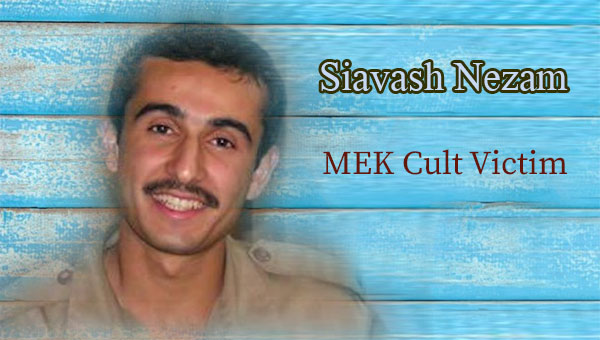Siavash Nezamolmolki was born in 1981 in Rasht, Iran. His father Hassan Nezamolmolki and his mother Nasrin Parsian were members of the Mujahedin Khalq Organization (the MEK). A year later, his parents took him abroad to join the MEK leaders in Europe. In 1987, the family were dispatched to Iraq to join the MEK military units in order to launch cross border attacks against Iran.
They were settled in Camp Ashraf where family life made no sense; children of the MEK members were kept in bases separated from their parents; they were only allowed to meet their parents in the weekends.
For Siavash, this imperfect family life lasted only three years. In 1990, Siavash was separated from his parents. At the time, about nine hundred children of MEK members were sent to Europe under the order of Massoud Rajavi. The nine-year-old Siavash met his mother for the last time and was then smuggled to Sweden by MEK agents. Like other MEK children, he spent life in homes of different MEK sympathizers and team houses of the MEK.
Siavash’s mother, Nasrin Parsian (Fazeleh) never saw her son again. She was killed in an accident in the road to Baghdad, in 1993. Some defectors of the MEK believe that Nasrin was killed under the order of the MEK leaders because she had started dissenting the group’s leaders in their so-called Elite council.

Ali Saeedi former member of the group considers Hassan Nezamolmolki, Nasrin’s husband as the operator of the deadly accident. “At that time every one knew that Nasrin Parsian, member of the Elite Council, had just expressed her opposition against the so-called ideological revolution forged by Massoud and Maryam Rajavi,” Ali Saeedi writes. “So, Massoud Rajavi planned to eliminate her and the plan was executed by her devoted husband in that alleged accident.”
A few years later, Siavash was once again returned to Camp Ashraf as what the MEK leaders call “militia force” while his mother had been not been there anymore. He had made to leave the life in Europe behind and to stay under the cult-like structure of the group in Iraqi deserts.
In July 2009, after the US army handed over the security of Camp Ashraf to Iraqi Police, the latter needed to build a station inside Camp Ashraf but they were encountered by a human shield made of MEK members. The disarmed rank and file of the group started a suicidal clash with Iraqi armed forces. The deadly clash ended with the killing of Siavash Nezamolmolki and 12 other members of the MEK. Siavash was 28 years old when he was victimized by the Cult of Rajavi.
Farhad, former member of the MEK who was also a militia write about Siavash’s fate, addressing him “I am still obsessed with this question: why did Rajavi ruthlessly victimize you and others of the rank and file who were too young? Most of us standing by your grave knew you from childhood.”
The MEK-run media glorify Siavash and his mother as martyrs of the cause of the group. In the memorial statement that was published for Siavash on the group’s website , there is a blank in front of the word “education”. This implies that Siavash had not finished his education. He had been brought to Iraq by the MEK leaders just in the middle of his studies. This has happened to many of militia members of the MEK.
In a detailed report on the fate of another militia called Amin Golmaryami, recently published by the German Zeit Magazine you read, “From the mid-1990s, some of their former teachers remembered that People’s Mojahedin children suddenly disappeared from Cologne. They suddenly stopped showing up in their classes, 14-, 15-, 16-year-old teenagers. A former teacher says today that he informed the Cologne Youth Welfare Office and the guardian Christoph Meertens about it.”
Siavashi’s father Hassan Nezamolmolki is still an ardent member of the Cult of Rajavi. He shows up in the group’s TV as political or military analyst. Former members of the group, Javad Firouzmand and Ali Saeedi testify that Hassan was Rajavi’s representative to communicate Saddam’s intelligence authorities and one of the torturers and interrogators of the group to suppress members.
Siavash had also an aunt, his father’s sister, Maryam Nezamolmolki who left the group after she was relocated in Albania. Former member of the MEK, Maryam Sanjabi writes about Siavash’s aunt as one of the female victims of the Cult: “Maryam Nezamolmolki hated the MEK leader because they had victimized her nephew. She had realized the crimes of the group leaders so she did not want to stay in that hellish system. She expressed her complaints publicly and the criminal Rajavi did not allow her to leave. Under Rajavi’s regulations, candidates and members of the Elite Council would be sentenced to death in case of defecting. Thus, Maryam Nezam was imprisoned and kept under mental and physical pressure in Camp Ashraf.”



